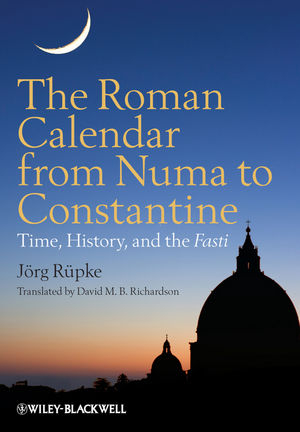
The Roman Calendar from Numa to Constantine
Wiley-Blackwell (Verlag)
978-0-470-65508-5 (ISBN)
This book provides a definitive account of the history of the Roman calendar, offering new reconstructions of its development that demand serious revisions to previous accounts.
Examines the critical stages of the technical, political, and religious history of the Roman calendar
Provides a comprehensive historical and social contextualization of ancient calendars and chronicles
Highlights the unique characteristics which are still visible in the most dominant modern global calendar
About the Author Jörg Rüpke is Fellow in Religious Studies at the Max Weber Centre of the University of Erfurt. His publications include Fasti sacerdotum: A Prosopography of Pagan, Jewish, and Christian Religious Officials in the City of Rome, 300 BC to AD 499 (trans. David Richardson, 2008), Religion of the Romans (2007), A Companion to Roman Religion (2007), and Religion and Law in Classical and Christian Rome (co-edited with C. Ando, 2006). About the Translator David M. B. Richardson has previously translated Fasti sacerdotum: A Prosopography of Pagan, Jewish, and Christian Religious Officials in the City of Rome, 300 BC to AD 499 (Jörg Rüpke, 2008), and contributed to the English translation of Brill's New Pauly Encyclopaedia of the Ancient World (2002 onwards).
Preface vii
Map 1 Distribution of preserved calendars (or calendar fragments) of the fasti type from the first century BCE to the fifth century CE viii
Table 1 List of known copies of fasti ix
1 Time’s Social Dimension 1
2 Observations on the Roman fasti 6
2.1 A Republican Version 6
2.2 Forms and Functions 8
2.3 The fasti and the Birth of Augustan Epigraphy 14
2.4 The Question of the Archetype 21
3 Towards an Early History of the Roman Calendar 23
3.1 Notions of a Prehistoric Calendar 23
3.2 The Structure of the Month 24
3.3 Market Cycles 32
3.4 Modes of Dating 34
4 The Introduction of the Republican Calendar 38
4.1 Timing and Motivation 38
4.2 The Character and Significance of the Reform 41
5 The Written Calendar 44
5.1 Gnaeus Flavius 44
5.2 NP Days and Feast-names 50
5.3 Cultic and Linguistic Details 55
5.4 The Purpose of the fasti 58
5.5 The Law of Hortensius 59
5.6 Implications for the Historiography of Roman Religion 64
5.7 Variants on Stone and Paper 66
6 The Lex Acilia and the Problem of Pontifical Intercalation 68
6.1 The Nature of the Measures 68
6.2 The Ritually Correct Method of Intercalation 69
6.3 Problems of Intercalation 79
6.4 Regulating Intercalation by Means of Laws 83
7 Reinterpretation of the fasti in the Temple of the Muses 87
7.1 Marcus Fulvius Nobilior, Triumphator 87
7.2 Temple Dedications in the fasti 95
7.3 Ennius 105
7.4 All fasti are Fulvian fasti 108
8 From Republic to Empire 109
8.1 Caesar’s Calendar Reform 109
8.2 The Calendar as Collective Memory 121
8.3 Augustus and the Power of Dates 124
8.4 The Calendar as Roman Breviary 134
9 The Disappearance of Marble Calendars 140
10 Calendar Monopoly and Competition between Calendars 146
10.1 One Calendar 146
10.2 Coexisting and Competing Developments 153
10.3 Eras 156
10.4 The Calculation of Easter 157
10.5 Weekly Cycles 160
10.6 Fasti Christiani? 169
11 The Calendar in the Public Realm 175
Abbreviations 183
References 185
Sources Index 209
General Index 215
| Erscheint lt. Verlag | 15.4.2011 |
|---|---|
| Übersetzer | David M. B. Richardson |
| Verlagsort | Hoboken |
| Sprache | englisch |
| Maße | 180 x 254 mm |
| Gewicht | 626 g |
| Themenwelt | Geschichte ► Allgemeine Geschichte ► Altertum / Antike |
| Geschichte ► Hilfswissenschaften ► Chronologie | |
| Naturwissenschaften ► Physik / Astronomie ► Astronomie / Astrophysik | |
| ISBN-10 | 0-470-65508-9 / 0470655089 |
| ISBN-13 | 978-0-470-65508-5 / 9780470655085 |
| Zustand | Neuware |
| Haben Sie eine Frage zum Produkt? |
aus dem Bereich


